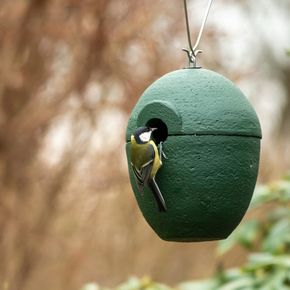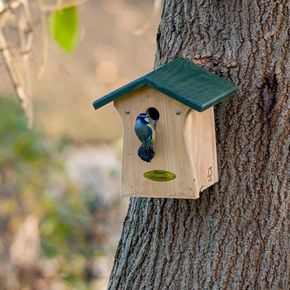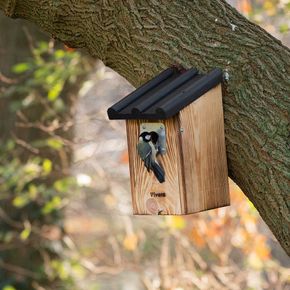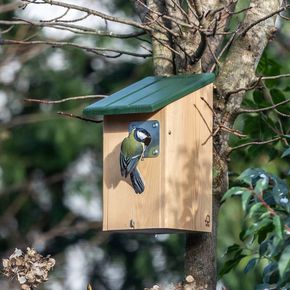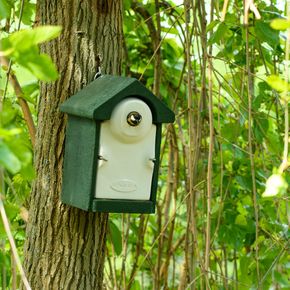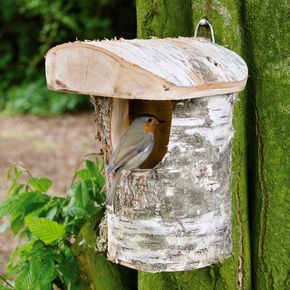
CJ Wildlife's Nest Box Week
From 30 October to 6 November, we’ll be celebrating CJ Wildlife’s Nest Box Week. This is separate from National Nest Box Week, which takes place from 14 to 21 February as birds prepare for the breeding season.
Nest boxes play two key roles: they provide safe winter shelter from the cold and wet weather, and they become valuable nesting sites in spring when birds are looking for suitable places to raise their young.

Benefits of WoodStone®
Why is the natural number of nesting sites decreasing?
Most animals are struggling to find suitable places to stay, as natural nesting sites are becoming rare. Birds living in or around cities like to nest in holes or crevices in house façades. As these are increasingly being plastered over during restorations, birds are finding fewer places to nest. Replacing old roof tiles also obstructs nesting holes, and these are missing from newer roofs.
There has been a decrease in old tree populations, which provide ideal habitable cavities. All of these nesting possibilities are becoming fewer and fewer, and in the majority of cases, humans are responsible for this. Therefore, our birds rely heavily on artificial nests, such as the ones we provide.
When should I hang a Nest Box?

Which nest box for which bird?
Artificial nests help birds find a suitable place to raise their young. But before choosing a nest box, we recommend that you spend some time identifying which birds visit your garden most often. Depending on which bird species you find, its best to choose a nest box design that is going to suit them best.
Across our range you will find a variety of nest boxes, which all vary in material and size, to help accommodate the needs of different bird species. The size of the entrance hole is a very important factor for example, as every size is not suitable for every bird. When choosing a nest box, the following guidelines can be used to give your garden birds the right home.

5 top tips for hanging nest boxes
These top tips have been designed to help you find the right place for your nest box, so that it will be quickly inhabited by local birdlife.
- It’s important to choose a quiet place that is difficult for cats and other nest predators to access! (Minimum height is 1.5 to 2 metres)
- Make sure that the nest box is installed in a place that is protected from wind, rain and sun! (Entrance hole oriented as far as possible to the east or northeast)
- If you hang your nest box near bushes, you will be helping young birds when they make their first attempts to fly
- Nest boxes with open fronts (half-caves, half-open nesting boxes) offer less protection than closed nesting boxes and should therefore be hung in a sheltered location (e.g. between dense ivy)
- To attach the nest box to a tree trunk, it is best to use an aluminium nail so you don’t damage the tree
Who are CJ Wildlife and what makes us different?
CJ Wildlife has been providing environmentally friendly nature conservation products for over 35 years. We only use eco-friendly raw materials and develop our products according to the needs of our native garden wildlife. In our range you will find a large range of products for the protection of birds, squirrels, hedgehogs, insects and bats. Whether you’re an expert in nature conservation or are just at the start of your journey, our products are for anyone who wants to protect local nature and help preserve biodiversity.
We manufacture a large part of our range in-house. This allows us to directly control both the quality of product finishing and the production process. Most of our products are exclusively available at CJ Wildlife. Collaborating with various conservation organisations around the world helps us to adapt and optimise our products so that they are ideally suited to the needs of your garden animals.
Find out more about our collaborations with our green partners, such as the National Trust and the Butterfly Conservation Trust.
The observations and findings of nature conservation organisations and the expertise of our own experts form the basis of our product developments. This pooled expertise enables us to create innovative products.
Here at CJ Wildlife we make sure the best materials are used in the production of our products and we only use the highest quality ingredients in our foods. Our green partners test our products before they are released, so we can be sure that you are really able to help wildlife by purchasing our products.









